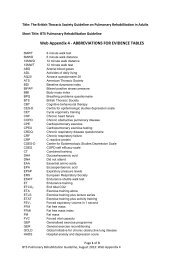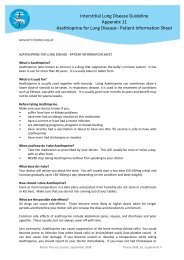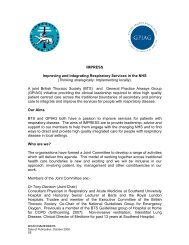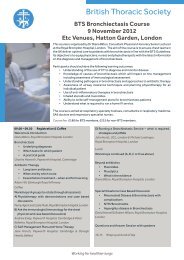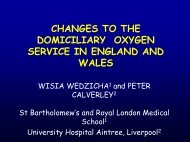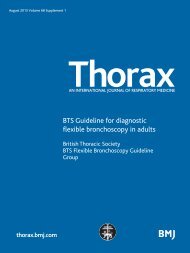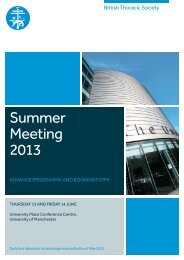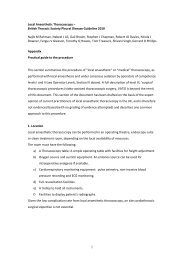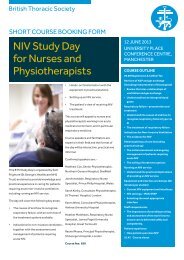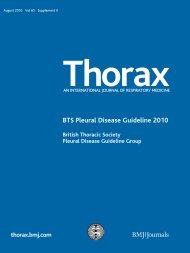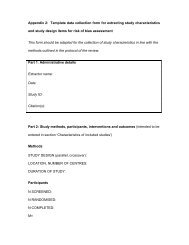Guidelines for the management of community ... - Brit Thoracic
Guidelines for the management of community ... - Brit Thoracic
Guidelines for the management of community ... - Brit Thoracic
Create successful ePaper yourself
Turn your PDF publications into a flip-book with our unique Google optimized e-Paper software.
BTS guidelines<br />
Table 4<br />
Recommendations <strong>for</strong> <strong>the</strong> microbiological investigation <strong>of</strong> <strong>community</strong> acquired pneumonia (CAP)<br />
Pneumonia severity (based on clinical judgement<br />
supported by severity scoring tool) Treatment site Preferred microbiological tests<br />
Low severity<br />
(eg, CURB65 = 0–1 or CRB-65 score = 0, ,3% mortality)<br />
Low severity<br />
(eg, CURB65 = 0–1, ,3% mortality) but admission<br />
indicated <strong>for</strong> reasons o<strong>the</strong>r than pneumonia severity<br />
(eg, social reasons)<br />
Moderate severity<br />
(eg, CURB65 = 2, 9% mortality)<br />
High severity<br />
(eg, CURB65 = 3–5, 15–40% mortality)<br />
Home<br />
Hospital<br />
Hospital<br />
Hospital<br />
None routinely.<br />
PCR, urine antigen or serological investigations* may be considered during outbreaks (eg,<br />
Legionnaires’ disease) or epidemic mycoplasma years, or when <strong>the</strong>re is a particular clinical or<br />
epidemiological reason.<br />
None routinely<br />
PCR, urine antigen or serological investigations* may be considered during outbreaks (eg,<br />
Legionnaires’ disease) or epidemic mycoplasma years, or when <strong>the</strong>re is a particular clinical or<br />
epidemiological reason.<br />
Blood cultures (minimum 20 ml)<br />
Sputum <strong>for</strong> routine culture and sensitivity tests <strong>for</strong> those who have not received prior<br />
antibiotics (¡Gram stain*)<br />
Pneumococcal urine antigen test<br />
Pleural fluid, if present, <strong>for</strong> microscopy, culture and pneumococcal antigen detection<br />
PCR or serological investigations* may be considered during mycoplasma years and/or<br />
periods <strong>of</strong> increased respiratory virus activity.<br />
Where legionella is suspected", investigations <strong>for</strong> legionella pneumonia:<br />
(a) urine <strong>for</strong> legionella antigen<br />
(b) sputum or o<strong>the</strong>r respiratory sample <strong>for</strong> legionella culture and direct immun<strong>of</strong>luorescence (if<br />
available). If urine antigen positive, ensure respiratory samples <strong>for</strong> legionella culture<br />
Blood cultures (minimum 20 ml)<br />
Sputum or o<strong>the</strong>r respiratory sample{ <strong>for</strong> routine culture and sensitivity tests (¡Gram stain{)<br />
Pleural fluid, if present, <strong>for</strong> microscopy, culture and pneumococal antigen detection.<br />
Pneumococcal urine antigen test<br />
Investigations <strong>for</strong> legionella pneumonia:<br />
(a) Urine <strong>for</strong> legionella antigen<br />
(b) Sputum or o<strong>the</strong>r respiratory sample{ <strong>for</strong> legionella culture and direct immun<strong>of</strong>luorescence<br />
(if available)<br />
Investigations <strong>for</strong> atypical and viral pathogens:**<br />
(a) If available, sputum or o<strong>the</strong>r respiratory sample <strong>for</strong> PCR or direct immun<strong>of</strong>luorescence (or<br />
o<strong>the</strong>r antigen detection test) <strong>for</strong> Mycoplasma pneumoniae Chlamydia spp, influenza A and B,<br />
parainfluenza 1–3, adenovirus, respiratory syncytial virus, Pneumocystis jirovecii (if at risk)<br />
(b) Consider initial and follow-up viral and ‘‘atypical pathogen’’ serology1<br />
*If PCR <strong>for</strong> respiratory viruses and atypical pathogens is readily available or obtainable locally, <strong>the</strong>n this would be preferred to serological investigations.<br />
{The routine use <strong>of</strong> sputum Gram stain is discussed in <strong>the</strong> text.<br />
{Consider obtaining lower respiratory tract samples by more invasive techniques such as bronchoscopy (usually after intubation) or percutanous fine needle aspiration <strong>for</strong> those who<br />
are skilled in this technique.<br />
1The use <strong>of</strong> paired serology tests <strong>for</strong> patients with high severity CAP is discussed in <strong>the</strong> text. If per<strong>for</strong>med, <strong>the</strong> date <strong>of</strong> onset <strong>of</strong> illness should be clearly indicated on <strong>the</strong> laboratory<br />
request <strong>for</strong>m.<br />
"Patients with clinical or epidemiological risk factors (travel, occupation, comorbid disease). Investigations should be considered <strong>for</strong> all patients with CAP during legionella<br />
outbreaks.<br />
**For patients unresponsive to b-lactam antibiotics or those with a strong suspicion <strong>of</strong> an ‘‘atypical’’ pathogen on clinical, radiographic or epidemiological grounds.<br />
c<br />
Urine antigen investigations, PCR <strong>of</strong> upper (eg, nose<br />
and throat swabs) or lower (eg, sputum) respiratory<br />
tract samples or serological investigations may be<br />
considered during outbreaks (eg, Legionnaires’ disease)<br />
or epidemic mycoplasma years, or when <strong>the</strong>re is<br />
a particular clinical or epidemiological reason. [D]<br />
5.11 What microbiological investigations should be per<strong>for</strong>med in<br />
patients admitted to hospital with CAP?<br />
The investigations that are recommended <strong>for</strong> patients admitted<br />
to hospital are summarised in table 4. More extensive<br />
microbiological investigations are recommended only <strong>for</strong><br />
patients with moderate or high severity CAP, unless <strong>the</strong>re are<br />
particular clinical or epidemiological features that warrant<br />
fur<strong>the</strong>r microbiological studies. Comments and recommendations<br />
regarding specific investigations are given below.<br />
5.11.1 Blood cultures<br />
Microbial causes <strong>of</strong> CAP that can be associated with bacteraemia<br />
include S pneumoniae, H influenzae, S aureus and K<br />
pneumoniae. Isolation <strong>of</strong> <strong>the</strong>se bacteria from blood cultures in<br />
patients with CAP is highly specific in determining <strong>the</strong><br />
microbial aetiology. Bacteraemia is also a marker <strong>of</strong> illness<br />
severity. However, many patients with CAP do not have an<br />
associated bacteraemia. Even in pneumococcal pneumonia <strong>the</strong><br />
sensitivity <strong>of</strong> blood cultures is at most only 25%, 94 202 [II] [II] and is<br />
even lower <strong>for</strong> patients given antibiotic treatment be<strong>for</strong>e<br />
admission. 129 [II] Several predominantly retrospective North<br />
American studies and reviews 203–206 [II] [III] [III] [III] have questioned<br />
<strong>the</strong> utility <strong>of</strong> routine blood cultures in patients hospitalised<br />
with CAP on grounds <strong>of</strong> low sensitivity, cost and negligible<br />
impact on antimicrobial <strong>management</strong>. However, despite <strong>the</strong>se<br />
limitations, most continue to recommend blood cultures in high<br />
severity CAP.<br />
Recommendations<br />
c Blood cultures are recommended <strong>for</strong> all patients with<br />
moderate and high severity CAP, preferably be<strong>for</strong>e<br />
antibiotic <strong>the</strong>rapy is commenced. [D]<br />
Thorax 2009;64(Suppl III):iii1–iii55. doi:10.1136/thx.2009.121434<br />
iii21



